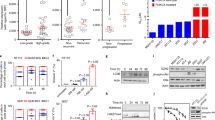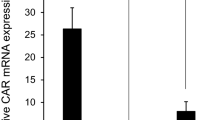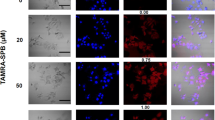Abstract
Targeted gene delivery for induced apoptosis of transitional cell carcinomas was carried out in vivo in mice via utilization of the murine cyclooxygenase type 2 (Cox-2) promoter (Tis10). MB49 cells, which constitutively overexpress Cox-2 like numerous other carcinomas, selectively expressed delivered genes that utilized this transcriptional control element. The products of the delivered genes were artificially inducible forms of caspases 3 and 9, which remained inactive until a chemical inducer of dimerization was later injected intraperitoneally. The genes were delivered intravesically as plasmids complexed with poly(ethylenimine). Significant improvements, in the form of reduced bladder mass, reduced tumor volume, anti-angiogenesis and inhibition of tumor growth were seen versus untreated or unactivated controls. In some instances, tumors were seen to go into complete remission. There were no apparent bystander effects associated with the treatments. This targeted gene therapy regimen could have wide applicability to numerous cancers due to constitutive overexpression of Cox-2.
This is a preview of subscription content, access via your institution
Access options
Subscribe to this journal
Receive 12 print issues and online access
$259.00 per year
only $21.58 per issue
Buy this article
- Purchase on Springer Link
- Instant access to full article PDF
Prices may be subject to local taxes which are calculated during checkout






Similar content being viewed by others
References
Ma H, Sumbilla C, Farrance IK, Klein MG, Inesi G . Cell specific expression of exogenous Ca2+ Transport ATPase (SERCA) in Cardiac Myocytes. Am J Physiol Cell Physiol 2004; 286: C556–C564.
Zhang Y, Schlachetzki F, Li JY, Boado RJ, Pardridge WM . Organ-specific gene expression in the rhesus monkey eye following intravenous non-viral gene transfer. Mol Vis 2003; 9: 465–472.
Kim S, Lin H, Barr E, Chu L, Leiden JM, Parmacek MS . Transcriptional targeting of replication-defective adenovirus transgene expression to smooth muscle cells in vivo. J Clin Invest 1997; 100: 1006–1014.
De Palma M, Venneri MA, Naldini L . In vivo targeting of tumor endothelial cells by systemic delivery of lentiviral vectors. Hum Gene Ther 2003; 14: 1193–1206.
Modlich U, Pugh CW, Bicknell R . Increasing endothelial cell-specific expression by the use of heterologous hypoxic and cytokine-inducible enhancers. Gene Therapy 2000; 7: 896–902.
Barker SD, Coolidge CJ, Kanerva A, Hakkarainen T, Yamamoto M, Liu B et al. The secretory leukoprotease inhibitor (SLPI) promoter for ovarian cancer gene therapy. J Gene Med 2003; 5: 300–310.
Yamamoto M, Davydova J, Wang M, Siegal GP, Krasnykh V, Vickers SM et al. Infectivity enhanced, cyclooxygenase-2 promoter-based conditionally replicative adenovirus for pancreatic cancer. Gastroenterology 2003; 125: 1203–1218.
Chell S, Kadi A, Williams AC, Paraskeva C . Mediators of PGE2 synthesis and signalling downstream of COX-2 represent potential targets for the prevention/treatment of colorectal cancer. Biochim Biophys Acta 2006; 1766: 104–119.
Lee A, Frischer J, Serur A, Huang J, Bae JO, Kornfield ZN et al. Inhibition of cyclooxygenase-2 disrupts tumor vascular mural cell recruitment and survival signaling. Cancer Res 2006; 66: 4378–4384.
Grimes KR, Warren GW, Fang F, Xu Y, St Clair WH . Cyclooxygenase-2 inhibitor, nimesulide, improves radiation treatment against non-small cell lung cancer both in vitro and in vivo. Oncol Rep 2006; 16: 771–776.
Kern MA, Haugg AM, Koch AF, Schilling T, Breuhahn K, Walczak H et al. Cyclooxygenase-2 inhibition induces apoptosis signaling via death receptors and mitochondria in hepatocellular carcinoma. Cancer Res 2006; 66: 7059–7066.
Kawamori T, Rao CV, Seibert K, Reddy BS . Chemopreventive activity of celecoxib, a specific cyclooxygenase-2 inhibitor, against colon carcinogenesis. Cancer Res 1998; 58: 409–412.
Fischer SM, Lo HH, Gordon GB, Seibert K, Kelloff G, Lubet RA et al. Chemopreventive activity of celecoxib, a specific cyclooxygenase-2 inhibitor, and indomethacin against ultraviolet light-induced skin carcinogenesis. Mol Carcinog 1999; 25: 231–240.
Reddy BS, Hirose Y, Lubet R, Steele V, Kelloff G, Paulson S et al. Chemoprevention of colon cancer by specific cyclooxygenase-2 inhibitor, celecoxib, administered during different stages of carcinogenesis. Cancer Res 2000; 60: 293–297.
Grosch S, Tegeder I, Niederberger E, Brautigam L, Geisslinger G . COX-2 independent induction of cell cycle arrest and apoptosis in colon cancer cells by the selective COX-2 inhibitor celecoxib. FASEB J 2001; 15: 2742–2744.
Song X, Lin HP, Johnson AJ, Tseng PH, Yang YT, Kulp SK et al. Cyclooxygenase-2, player or spectator in cyclooxygenase-2 inhibitor-induced apoptosis in prostate cancer cells. J Natl Cancer Inst 2002; 94: 585–591.
Shamma A, Yamamoto H, Doki Y, Okami J, Kondo M, Fujiwara Y et al. Upregulation of cyclooxygenase-2 in squamous carcinogenesis of the esophagus. Clin Cancer Res 2000; 6: 1229–1238.
Rajnakova A, Moochhala S, Goh PM, Ngoi S . Expression of nitric oxide synthase, cyclooxygenase, and p53 in different stages of human gastric cancer. Cancer Lett 2001; 172: 177–185.
Ferrandez A, Prescott S, Burt RW . COX-2 and colorectal cancer. Curr Pharm Des 2003; 9: 2229–2251.
Bostrom PJ, Aaltonen V, Soderstrom KO, Uotila P, Laato M . Expression of cyclooxygenase-1 and -2 in urinary bladder carcinomas in vivo and in vitro and prostaglandin E2 synthesis in cultured bladder cancer cells. Pathology 2001; 33: 469–474.
Shirahama T, Sakakura C . Overexpression of cyclooxygenase-2 in squamous cell carcinoma of the urinary bladder. Clin Cancer Res 2001; 7: 558–561.
Yoshimura R, Sano H, Mitsuhashi M, Kohno M, Charqui J, Wada S . Expression of cyclooxygenase-2 in patients with bladder carcinoma. J Urol 2001; 165: 1468–1472.
Zhang X, Turner C, Godbey WT . Comparison of caspase genes for the induction of apoptosis following gene delivery. 2008 (submitted).
Shariat SF, Desai S, Song W, Khan T, Zhao J, Nguyen C et al. Adenovirus-mediated transfer of inducible caspases: a novel ‘death switch’ gene therapeutic approach to prostate cancer. Cancer Res 2001; 61: 2562–2571.
Shinoura N, Sakurai S, Asai A, Kirino T, Hamada H . Caspase-9 transduction overrides the resistance mechanism against p53-mediated apoptosis in U-87MG glioma cells. Neurosurgery 2001; 49: 177–186.
Shinoura N, Sakurai S, Asai A, Kirino T, Hamada H . Transduction of Apaf-1 or caspase-9 induces apoptosis in A-172 cells that are resistant to p53-mediated apoptosis. Biochem Biophys Res Commun 2000; 272: 667–673.
Fan L, Freeman KW, Khan T, Pham E, Spencer DM . Improved artificial death switches based on caspases and FADD. Hum Gene Ther 1999; 10: 2273–2285.
Clackson T, Yang W, Rozamus LW, Hatada M, Amara JF, Rollins CT et al. Redesigning an FKBP-ligand interface to generate chemical dimerizers with novel specificity. Proc Natl Acad Sci USA 1998; 95: 10437–10442.
Wencker D, Chandra M, Nquyen K, Miao W, Garantziotis S, Factor SM et al. A mechanistic role for cardiac myocyte apoptosis in heart failure. J Clin Invest 2003; 111: 1497–1504.
Mallet VO, Mitchell C, Guidotti JE, Jaffray P, Fabre M, Spencer D et al. Conditional cell ablation by tight control of caspase-3 dimerization in transgenic mice. Nat Biotechnol 2002; 20: 1234–1239.
Gunther JH, Jurczok A, Wulf T, Brandau S, Deinert I, Jocham D et al. Optimizing syngeneic orthotopic murine bladder cancer (MB49). Cancer Res 1999; 59: 2834–2837.
Godbey WT, Atala A . Directed apoptosis in Cox-2-overexpressing cancer cells through expression-targeted gene delivery. Gene Therapy 2003; 10: 1519–1527.
Pfaffl MW . A new mathematical model for relative quantification in real-time RT-PCR. Nucleic Acids Res 2001; 29: e45.
Wong WW . ICE family proteases in inflammation and apoptosis. Agents Actions Suppl 1998; 49: 5–13.
Bishop CE, Hata D . Molecular cloning and sequence analysis of a mouse Y chromosome RNA transcript expressed in the testis. Nucleic Acids Res 1987; 15: 2959–2969.
Jones MK, Wang H, Peskar BM, Levin E, Itani RM, Sarfeh IJ et al. Inhibition of angiogenesis by nonsteroidal anti-inflammatory drugs: insight into mechanisms and implications for cancer growth and ulcer healing. Nat Med 1999; 5: 1418–1423.
Tsujii M, Kawano S, Tsuji S, Sawaoka H, Hori M, Dubois RN . Cyclooxygenase regulates angiogenesis induced by colon cancer cells. Cell 1998; 93: 705–716.
Davies G, Salter J, Hills M, Martin LA, Sacks N, Dowsett M . Correlation between cyclooxygenase-2 expression and angiogenesis in human breast cancer. Clin Cancer Res 2003; 9: 2651–2656.
Uefuji K, Ichikura T, Mochizuki H . Cyclooxygenase-2 expression is related to prostaglandin biosynthesis and angiogenesis in human gastric cancer. Clin Cancer Res 2000; 6: 135–138.
Fujimoto J, Toyoki H, Sato E, Sakaguchi H, Jahan I, Alam SM et al. Expression of cyclooxygenase-2 related to angiogenesis in uterine cervical cancers. J Biomed Sci 2006; 13: 825–832.
Ohsawa M, Fukushima H, Ikuri Y, Inoue T, Shirai N, Sugama Y et al. Expression of cyclooxygenase-2 in Hodgkin's lymphoma, its role in cell proliferation and angiogenesis. Leuk Lymphoma 2006; 47: 1863–1871.
Loskog A, Dzojic H, Vikman S, Ninalga C, Essand M, Korsgren O et al. Adenovirus CD40 ligand gene therapy counteracts immune escape mechanisms in the tumor microenvironment. J Immunol 2004; 172: 7200–7205.
Loskog AS, Fransson ME, Totterman TT . AdCD40 L gene therapy counteracts T regulatory cells and cures aggressive tumors in an orthotopic bladder cancer model. Clin Cancer Res 2005; 11: 8816–8821.
Wu Q, Mahendran R, Esuvaranathan K . Nonviral cytokine gene therapy on an orthotopic bladder cancer model. Clin Cancer Res 2003; 9: 4522–4528.
Shirakawa T, Hamada K, Zhang Z, Okada H, Tagawa M, Kamidono S et al. A cox-2 promoter-based replication-selective adenoviral vector to target the cox-2-expressing human bladder cancer cells. Clin Cancer Res 2004; 10: 4342–4348.
Acknowledgements
We thank George Taylor, MD, and Patricia Dunning, RT(r), for assistance with ultrasound experiments, Carol Pilbeam, PhD for providing the TIS10 (murine Cox-2) promoter, ARIAD (www.ariad.com/regulationkits) for providing significant amounts of AP20187, and John C Prindle Jr, PhD for numerical discussions. This work was funded, in part, by the Louisiana Board of Regents (LEQSF(2004-07)-RD-A-28).
Author information
Authors and Affiliations
Corresponding author
Rights and permissions
About this article
Cite this article
Zhang, X., Atala, A. & Godbey, W. Expression-targeted gene therapy for the treatment of transitional cell carcinoma. Cancer Gene Ther 15, 543–552 (2008). https://doi.org/10.1038/cgt.2008.7
Received:
Revised:
Accepted:
Published:
Issue Date:
DOI: https://doi.org/10.1038/cgt.2008.7
Keywords
This article is cited by
-
Preclinical evaluation of VAX-IP, a novel bacterial minicell-based biopharmaceutical for nonmuscle invasive bladder cancer
Molecular Therapy - Oncolytics (2016)
-
Preclinical evaluation of a gene therapy treatment for transitional cell carcinoma
Cancer Gene Therapy (2011)



